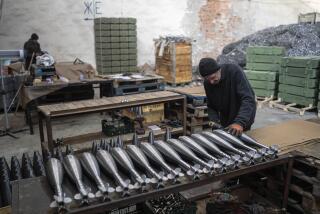Pentagon Seeks to Produce Cheaper Wartime Weapons
- Share via
WASHINGTON — The Defense Department, as part of the first effort since 1939 to draft a budget detailing munitions needed in a prolonged war, has directed the armed services to take a throwaway approach in designing some of the armaments that would be exhausted quickly when shooting started.
The idea is to formalize a double standard for defense contractors. They would still have to build munitions with a long shelf life for peacetime but would be relieved of that and other requirements in wartime so weapons that would be shot up shortly after leaving the factory could be built faster at less cost.
Fred C. Ikle, undersecretary of defense for policy, said Friday that the Navy is far along on the effort, having helped produce a half-price torpedo, for instance, and that the other services are expected to devise similar savings.
Expensive Gadgetry
The bargain-basement approach has been applied on air-to-air missiles that would be shot during aerial dogfights and on sonobuoys that would be dropped into the ocean by the thousands to help detect enemy submarines and torpedoes.
If the Navy knew exactly where the sonobuoys would be used, they could be built without the expensive gadgetry that keeps them operational for years in all kinds of climates.
Ikle is chairman of a Pentagon group that has asked the services to list what items would be exhausted first in early battles of a major war.
The list of what would be needed in the first six months of such a war, he said, will be distilled into an emergency budget request this year but kept in a Pentagon drawer unless war should break out. Then the document could be forwarded immediately for congressional approval.
‘An Educational Device’
Ikle described drafting of the dummy budget as “an educational device.” The last time it was done was in 1939, before World War II, he said.
The exercise “will focus the mind” not only on what would be needed in the first months of a war but industry’s ability to respond to the orders, Ikle said.
He said a demonstrated U.S. capacity for volume production immediately after the outbreak of war would “add to deterrence” by showing potential enemies that the U.S. military has staying power.
The mountain of munitions shot up during the Yom Kippur War of 1973 between Egypt and Israel has given impetus to the U.S. effort to find ways to launch high-volume production just after a war starts.
War-Fighting Budget
The United States has fought “every big war with the forces built during the war,” Ikle said, but may not have that luxury in the future. Producing a war-fighting budget now will save precious months later, he added.
Defense industry executives have been meeting with Ikle and other Pentagon officials in connection with drafting what is called the Emergency Procurement Budget and about problems standing in the way of a surge in production.
Some military officials working on the bargain-basement approach said the defense industry appears cool to the idea of lowering specifications for fear that it will institutionalize the cost-cutting measures and reduce profits from what critics call “gold plating.”
That refers to contractors’ adding the most sophisticated and recent accessories to weapons, additions that critics say are frills.
Backbones of Weapons
As another part of the effort to increase the defense industry’s “surge capacity,” the Pentagon has persuaded Congress to set aside money to buy and lay away the backbones of weapons that would be needed in a hurry if war begins.
Congress has set aside $16.2 million to buy long-lead-time items for the Army’s TOW anti-tank missile, for example.
With these items in hand, Ikle said, industry could increase TOW missile production from 1,000 to 2,500 missiles per month within six months.
More to Read
Sign up for Essential California
The most important California stories and recommendations in your inbox every morning.
You may occasionally receive promotional content from the Los Angeles Times.










